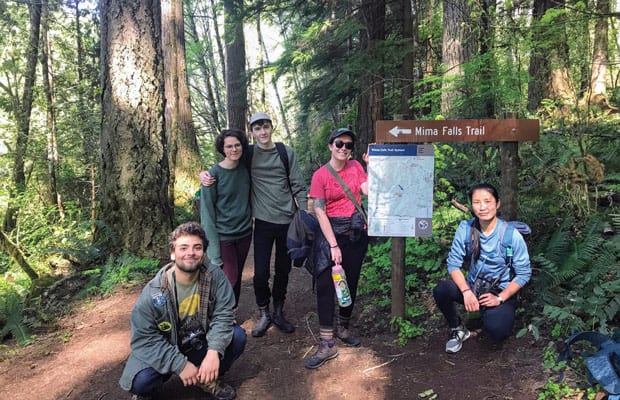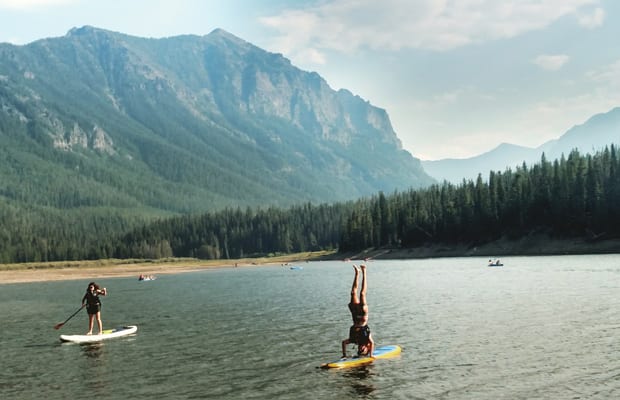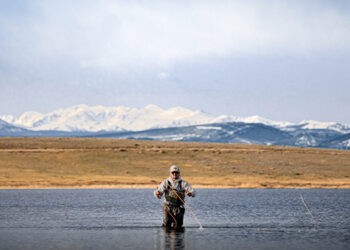After 20 minutes in a natural setting, cortisol levels decrease significantly, as reported by the International Journal of Environmental Research and Public Health.
In fact, one of the goals of The Evergreen State College’s The Outdoor Program (TOP) is to connect students to nature. Sam Hensold, the recreation coordinator and club advisor for TOP, said the other two are to build student community and personal growth. “To that end, we offer short clinics, on-campus outings, day trips and overnight trips in the Pacific Northwest,” he said. “We’re lucky enough to have campus resources such as 1,000-plus acres of continuous forest, in addition to a school-owned beach and boat launch on the Puget Sound.”
Using the above features, Hensold shared some of their most popular programs: “glow hikes” that take place during the night, kayaking, the outdoor climbing wall, and rock-climbing trips to Oregon and Washington.
Over at Montana State University, two key programs have been first-year orientation trips and the avalanche program. Dan Sandberg, the assistant director of the outdoor recreation program, said they choose programming based on student interest and institutional support, as well as student leadership opportunities.
Sandberg explained the outdoor recreation program and the dean of students work closely together. With that institutional support, it’s made it easier for the outdoor recreation program to put itself out there.

In terms of deciding what to offer each quarter, Hensold said it depends on several factors: what public lands they have operating permits for, student leader availability and skills, professional staff availability for higher-risk activities, and student demand. “Surveys can be helpful to track changing trends, but past interest is the most reliable indicator of future interest,” he said. “Student leaders also have the ability to propose new offerings, which is a great way to not get stuck in the same cycle of programs.”
That student interest is critical. “Running a quality and safe outdoor program takes substantial resources and staff time, so there needs to be enough interest to justify the long-term investment,” said Hensold. “If approached as ‘just another program’ to have because your peer schools do, it may not be worth the time, resources and risk.”
A student leadership element is also key in picking what to offer. Sandberg said they put a lot of weight in student leadership opportunities in the outdoor recreation program. Planning, teaching technical skills, and making sure staff are involved for the long training process prepares students to lead trips. While it might be easier to let professional staff just do it, Sandberg said they want to grow their students and give them tools they can use in the career world.
Collaborating is another key element to making your outdoor recreation program a success. Sandberg has realized this through the relationship with the dean of students. Partnering with other departments on campus leads to credibility and means another voice speaking for your outdoor program.
Hensold said he’s seen this sort of collaboration with student clubs, housing and the wellness center. One example he shared was a partnership with the Vegan Club. They offered a ‘food dehydrating for backpacking’ workshop and a plant-based backpacking trip. “I have found if you’re trying to reach new participants, doing so through an already established group is most effective,” shared Hensold.

However, it’s key to remember to collaborate with your peers in the field as well. Hensold highly recommended becoming a member of the Association of Outdoor Recreation and Education. “Even if you don’t attend their annual conference, it gives you the opportunity to connect directly with other professionals in the field, ask questions about best practices and access year-round training opportunities,” he said.
Sandberg noted their unique approach to outdoor recreation is due to teamwork. It’s key to try and take elements from different programs, and mold them together. “We have a pretty collaborative team at Montana State,” he said. “It’s really a wonderful opportunity to brainstorm with other folks that have a lot of experience.”
But even with the best programming, without the proper equipment your program won’t succeed. Hensold said when making purchases, he uses Keith Bontrager’s saying, “Strong, light, cheap — pick two.” He’ll usually go for strong and cheap, looking for quality equipment that lasts while shopping outdoor brands that offer good discounts. Hensold will order a handful of items, test them in the field and then make his larger purchase.
One last piece of advice has to do with how the students handle the equipment: “When it comes to program use, the latest, greatest and lightest gear is often a terrible choice,” he said. “To quote another adage, ‘It’s a rental. Don’t be gentle.’”
Getting your students to feel that benefit of the great outdoors requires you to think about a lot in planning and deciding on programming. But in Hensold’s eyes, the time and effort is certainly worth the benefit. “An outdoor program can offer amazing opportunities for your student body, in addition to your institution’s recruitment and retention efforts,” he shared.










